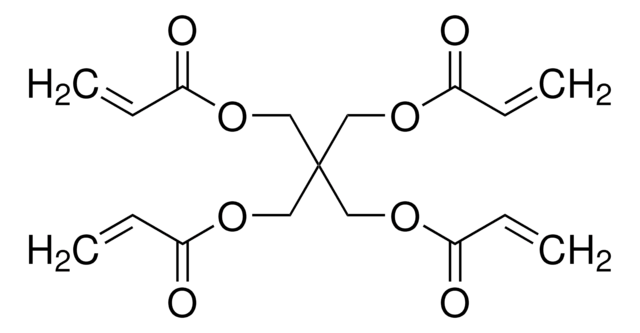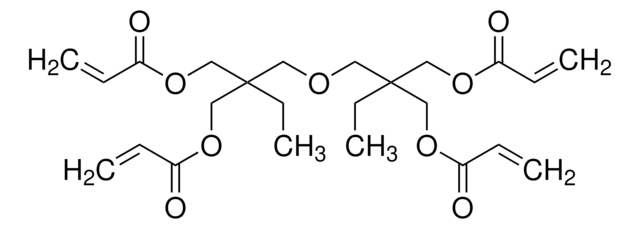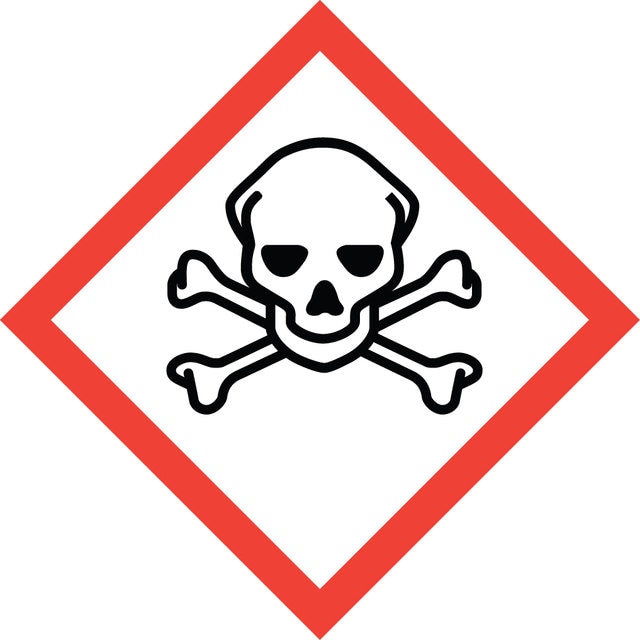411744
1,4-Butanediol diacrylate
technical grade, contains ~75 ppm hydroquinone as inhibitor
동의어(들):
1,4-Bis(acryloyloxy)butane, Tetramethylene diacrylate
로그인조직 및 계약 가격 보기
모든 사진(3)
About This Item
Linear Formula:
(H2C=CHCO2CH2CH2-)2
CAS Number:
Molecular Weight:
198.22
EC Number:
MDL number:
UNSPSC 코드:
12162002
PubChem Substance ID:
NACRES:
NA.23
추천 제품
Grade
technical grade
분석
87%
양식
liquid
포함
~75 ppm hydroquinone as inhibitor
refractive index
n20/D 1.456 (lit.)
bp
83 °C/0.3 mmHg (lit.)
density
1.051 g/mL at 25 °C (lit.)
저장 온도
2-8°C
SMILES string
C=CC(=O)OCCCCOC(=O)C=C
InChI
1S/C10H14O4/c1-3-9(11)13-7-5-6-8-14-10(12)4-2/h3-4H,1-2,5-8H2
InChI key
JHWGFJBTMHEZME-UHFFFAOYSA-N
일반 설명
1,4-Butanediol diacrylate(BDDA) is an acrylate monomer and a multifunctional crosslinking agent. It has a relatively low viscosity and undergoes photopolymerization, initiated by UV radiation. BDDA contributes to the flexibility and elasticity of the cured materials. It is used in optical films,3D printing, tissue engineering, dental composites, UV-curable adhesives, and sealants.
애플리케이션
1,4-Butanediol diacrylate can be used:
- As a precursor to synthesize joint-linker hydrogels with good mechanical strength and used as scaffold materials in bone tissue engineering as biomimetics for natural tissues and also in drug delivery systems.
- To prepare anti-fouling coating for dental composites.
- As a crosslinking agent to prepare hydrophobic acrylic intraocular lens(IOL) materials with reduced glistening.
- As a precursor to fabricate poly(β-amino ester) based solid polymer electrolytefilms for Li-ion batteries. BDDA enhances the ionic conductivity of theelectrolyte films.
신호어
Danger
유해 및 위험 성명서
Hazard Classifications
Acute Tox. 3 Dermal - Acute Tox. 4 Inhalation - Acute Tox. 4 Oral - Aquatic Chronic 3 - Eye Dam. 1 - Skin Corr. 1B - Skin Sens. 1A
Storage Class Code
6.1A - Combustible acute toxic Cat. 1 and 2 / very toxic hazardous materials
WGK
WGK 2
Flash Point (°F)
>235.4 °F
Flash Point (°C)
> 113 °C
이미 열람한 고객
Erik Oude Blenke et al.
Journal of controlled release : official journal of the Controlled Release Society, 317, 154-165 (2019-11-26)
Small, synthetic oligonucleotides (ON) are of great interest as potential disease modifying drugs, mainly because of their ability to modulate previously undruggable target mutations. To date, therapeutic applications of ON are, however, limited by their physicochemical properties, including poor stability
Y Sakai et al.
Bioscience, biotechnology, and biochemistry, 63(4), 688-697 (1999-06-11)
A carboxylesterase that is responsible for conversion of 1,4-butanediol diacrylate (BDA) to 4-hydroxybutyl acrylate (4HBA) was found in Brevibacterium lines IFO 12171, and purified to homogeneity. The purified enzyme was active toward a variety of diesters of ethylene glycol, 1,4-butanediol
Swelling studies of super water retainer acrylamide/crotonic acid hydrogels crosslinked by trimethylolpropane triacrylate and 1, 4-butanediol dimethacrylate.
Karadag E and Saraydin D
Polymer Bull., 48(3), 299-307 (2002)
Wei Dong et al.
Acta biochimica et biophysica Sinica, 38(11), 780-787 (2006-11-09)
Polyethylenimine (PEI) has been known as an efficient gene carrier with the highest cationic charge potential. High transfection efficiency of PEI, along with its cytotoxicity, strongly depends on its molecular weight. To enhance its gene delivery efficiency and minimize cytotoxicity
Hyejoong Jeong et al.
Small (Weinheim an der Bergstrasse, Germany), 12(40), 5572-5578 (2016-10-21)
A method to control activation of a DNA nanodevice by supplying a complementary DNA (cDNA) strand from an electro-responsive nanoplatform is reported. To develop functional nanoplatform, hexalayer nanofilm is precisely designed by layer-by-layer assembly technique based on electrostatic interaction with
자사의 과학자팀은 생명 과학, 재료 과학, 화학 합성, 크로마토그래피, 분석 및 기타 많은 영역을 포함한 모든 과학 분야에 경험이 있습니다..
고객지원팀으로 연락바랍니다.













